Ever since we spotted a rain barrel in action on our visit to Matt & Kristin’s house last fall, Sherry and I have been itching to harness the power of our own otherwise wasted rainwater. So we participated in a recent rain barrel making workshop offered locally and we’re here to pass along the play by play.
First things first – why rain barrels? Well, placed under one of your downspouts, rain barrels conveniently collect rainwater that you can use to water gardens and lawns, wash cars or even fill birdbaths and ponds. A 1000 square foot roof yields about 600 gallons per inch of rainfall, so that’s a lot of water (and money) to be saved. We’ve even seen ’em hooked up to a soaker hose for easy and free garden watering. Novel idea, eh?
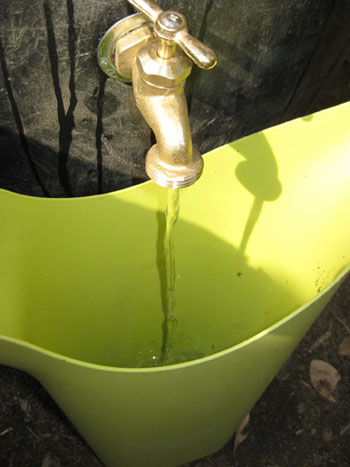
Rain barrels are relatively easy to make, but finding the barrel can be a challenge. Which is why many people will purchase them already assembled for upwards of $120. Needless to say, we were thrilled to find a local workshop that provided the tools, equipment and instruction for only $40. They provided everyone with a 50 gallon food grade plastic barrel… that just happened to have a previous life as an olive shipping vessel. Funny, huh? Sherry said it made her mouth water.
The first step was drilling the hole for the faucet. You’ll want to drill it as low as possible (since the water below the hole won’t flow out) but not too low that you can’t attach a hose or place a watering can under it (which obviously would be no good). Here’s Sherry sitting on our barrel to keep it from rolling while one of the volunteers operated the hole saw (a regular drill with a hole-cutting attachment). In less than 20 seconds, we had a hole for our faucet.
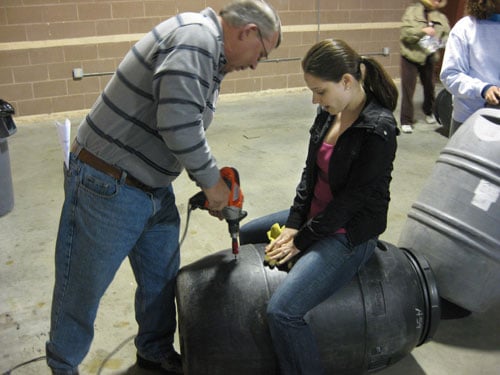
You’ll want to keep the barrel on its side and then use your faucet (or “hose bibb”) to thread the plastic edges of the hole. You’ll do this by screwing it all the way into and back out of your newly made hole once. It may take a little bit of force to get the faucet threads to catch, but be careful not to push it so hard that you damage the plastic threads you’re creating. In under a minute we had made our threads and removed the faucet for the next step…
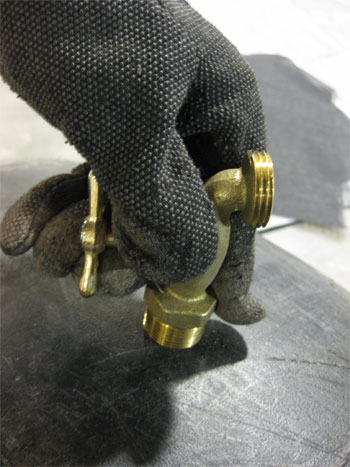
Once you’ve unscrewed the faucet, you’ll want to apply a thin line of caulk around the edge of the hole:
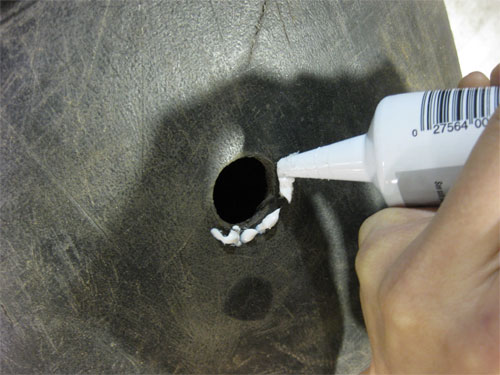
Then you’ll place a reducing washer over the hole, with the caulk acting as the adhesive. Reducing washers have a raised lip on the inner rim, and that raised portion should go against the barrel.
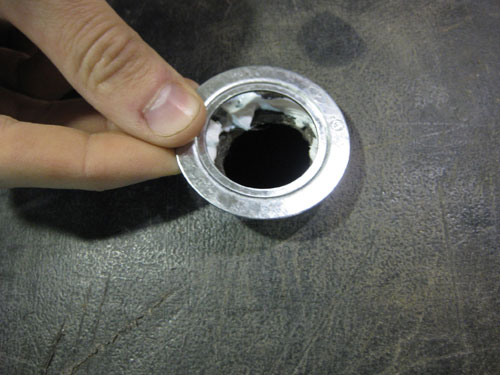
With the reducing washer firmly in place, you can screw your faucet back into place for good (this will be a lot easier since you’ve already created threads by screwing the faucet into the hole and removing it a few steps back). When it’s firmly in place, it should look something like this:
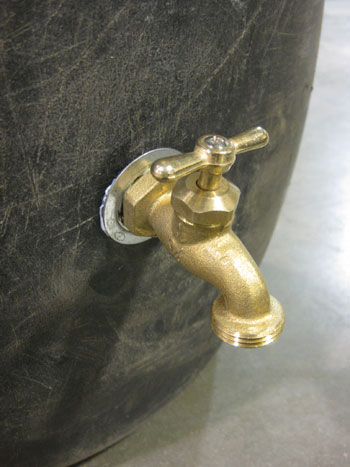
Now that you’ve created a watertight seal on the outside – here comes the fun part – you’ve gotta do the same on the INSIDE. Yep, time to crawl inside the barrel. You’d think this would be the perfect job for a petite person like my 5’2″ wife. Nope, somehow I got that assignment (and Sherry kept her job as barrel sitter to keep me from rolling away).
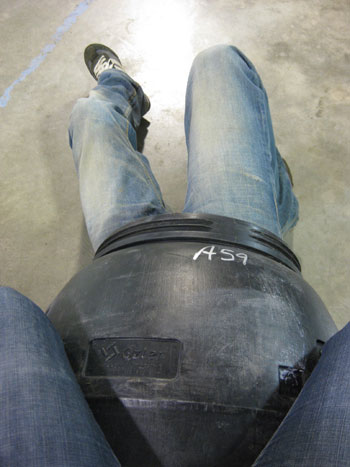
Inside the barrel, you’ll be repeating the process with the caulk and reducing washer – so remember to bring those with you when you go in. You’ll also want to bring a flashlight, because it’s dark in there (and it may smell like olives). Once you’ve got your washer caulked in place, you’ll screw on a locknut to secure the faucet. You’ll probably need the help of some pliers to ensure you’ve got the locknut on there nice and tight.
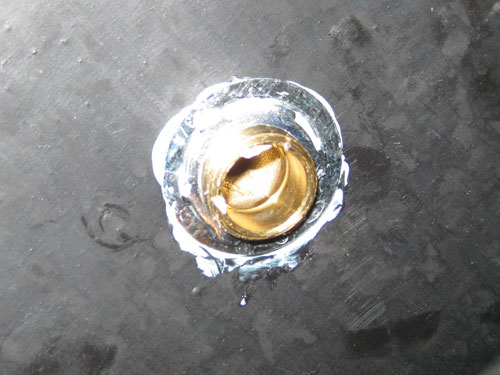
Your partner should stay sitting on the barrel to keep it from rolling away throughout the process. Or if you’re Sherry, you could use the opportunity to snap photos of your husband looking like, and I quote, a “California Raisin.” All I needed were some oversized gloves and a saxophone.
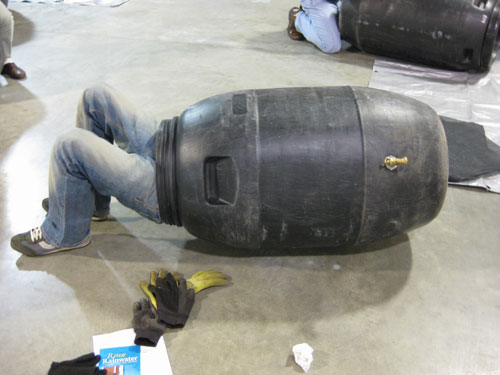
That completes the process of attaching the faucet. We did have the option of repeating the process at the top of the barrel with a “rigid nipple.” Basically, it’s an overflow spout that you could use to connect multiple barrels together. Since we’ll be a one barrel family for now, we’ve just opted for the overflow to come out the top (meaning when the barrel fills up with water, the excess spillover will do just that- spill over the top).
Speaking of the top – the barrels we were provided already had 6″ holes drilled in their lids. So all we had to do was screw the lid on over a tight mesh mosquito screen to keep any standing-water-lovin’ bugs out of our barrel. Here’s Sherry with our finished product:
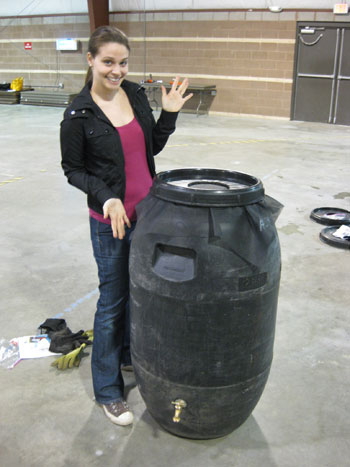
That would’ve been the end of our workshop adventure, but I guess some other people working near us took note of my locknut-tightening skills. Before I knew it I was climbing into not one, not two, but three other barrels to help other barrel-makers ensure that their faucets were secure. And should we be surprised that Sherry seized the opportunity to take more photos of me in those barrels?
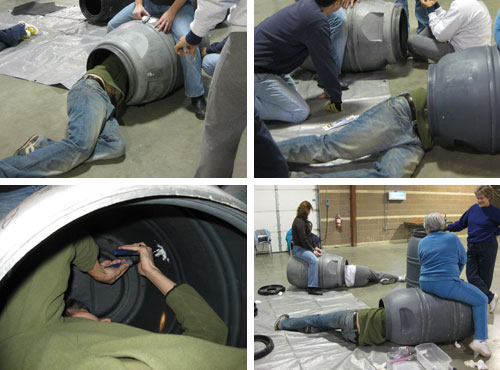
Once I finished barrel diving, we got the thing crammed into the backseat of our car and took it home for placement in our backyard. We picked a downspout at the edge of our driveway that was completely hidden from the front of the house, and mostly hidden from the side (let’s be honest, rain barrels don’t scream curb appeal). Luckily the placement will be super convenient for Sherry’s new back garden (stay tuned to see what sorts of edible goodies and purty bloomers she’s planning to grow).
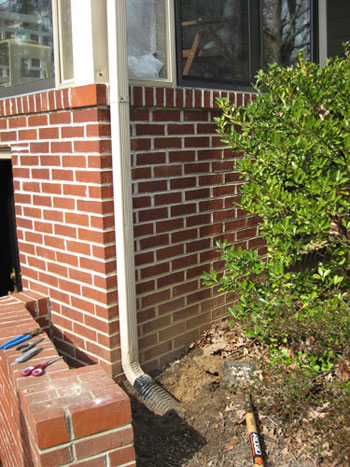
Then we just had to adjust the height of our downspout so it would spill into the top of the barrel. We detached the elbow at the bottom of the spout and dug out the underground plastic tubing that had been in place (and because we didn’t have any fancy metal snips with us, we broke out a box cutter once we figured out our desired height). Here’s Sherry making the cut while I stood by and watched. She’s hardcore. Maybe she was trying to make up for all the barrel-crawling I did?
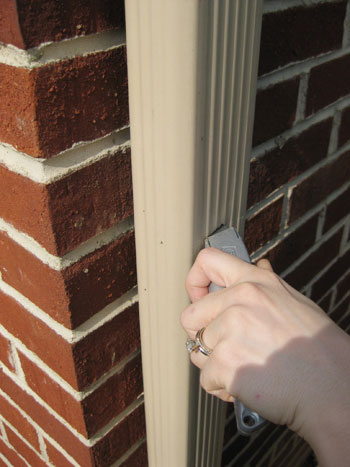
It did the trick, and with the gutter cut to the right height we just reattached the existing end spout and slid the barrel into place underneath it. Voila. Bring on the rain.
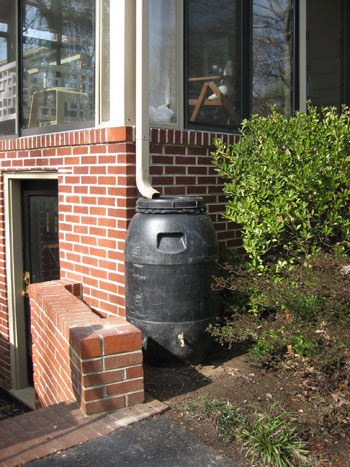
We should note that it’s extremely important that the barrel sits on level ground (you may want to use a shovel to level the ground and even lay some sand to be sure). A full barrel can weight up to 450lbs so you don’t want it tipping over on you. Of course we’re going to have to do a few more rain dances before ours will get that heavy. Bring it on Mother Nature.
Do any of you guys already use rain barrels? Any advice or tips for us newbies?
If you’re in Richmond and are looking to make a barrel of your own, check out upcoming workshops through Chesterfield County ($40) and Tricycle Gardens ($75).

Russ says
Awesome tutorial. We recently bought a house in Colorado, and the foundation on one side is a little lousy because our gutters had no where to drain. Got a couple barrels from my auto shop, and we’re gonna rig up some rain catchers so the house doesn’t sink into the ground. Thanks!
ca says
How has the rain barrel worked out for you? I’ve always been interested in them but when I did some research I found articles saying they’re not really “green”. That’s why I was wondering what your experience has been.
First, they said a typical home room can produce 600-1000 gallons or more in a decent rain. So when it comes to preventing stormwater runoff, the barrel catches 5-8% of the water coming off your roof and the other 95% just runs off as usual. In other words – no dent in runoff. And, most home roofs are made of shingles and they suggest NOT using water from your roof to water your edibles.
And when it comes to watering your yard or plants – well, during the rainy season you don’t need to, that’s what the rainy season is for. Most people spend more time wishing their yards WEREN’T growing so fast in the rainy season. lol. Besides, if you really want to play it “green” you can choose plants that grow well in your environment and don’t require special care year-round.
They say that when the dry season comes and you want to use that water you’ll find out that 50 gallons won’t even cover a 10′ x 10′ yard. So you only get to do a little watering and your barrel’s empty again (til next rainy season).
So the research I read seemed to indicate that unless you invest in something larger like a cistern, the rainbarrels are cute but not very green. This really disappointed me so I wanted to find out what your experience has been.
YoungHouseLove says
We just use the rain barrel water to water our non-edibles (which are about 95 of our plantings) – and it does the trick exclusively. So we don’t use a hose anymore for any of our front, side, or back gardens/borders/plants. Although it might not catch all the runoff from the whole roof, it’s enough to water everything we need with leftover in the barrel (we don’t water the yard with it, we just do planting beds and let the yard fare for itself, which works in our climate). Hope it helps!
xo
s
Phyllis D. says
My husband and I have a number of rain barrels at the front and back of our house and most have screens to keep out the mosquitoes. However one plastic barrel that was given to us, was open at the top which makes it great for quickly filling a watering can or bucket. To solve the mosquito problem, my husband added a few goldfish and they are happy to eat the larvae. Problem solved! The fish are so good at their job, that we have to supplement with fish food.
YoungHouseLove says
No way!
xo
s
Grace says
I love this idea!!! Tks!
Al says
Hey Sherry,
Just wondering if you guys have redone your guttering? I can’t find any posts on it. Love your blog btw!
YoungHouseLove says
We haven’t (we actually don’t have any gutters on this house except for one small one behind the sunroom – which would mean a rain barrel would be on the deck). So we have to get gutters added and then hopefully get a barrel somewhere out of the way!
xo
s
Ryan says
I thought it was illegal to collect rain water? Maybe Im losing my mind lol.
YoungHouseLove says
I think it might be in different states (in VA, it’s encouraged).
xo
s
jonny123 says
Thank you for posting the tutorial. I have built a lot of rain barrels myself, and i used to use a design similar to this one. However, when the downspout is routed directly into the top of the barrel like that, often times a 3/4″ overflow is not sufficient to prevent overflow and/or pooling around the foundation.
Forgive the plug, but have you seen the DIY construction kit for rain barrels offered by the “rain brothers”? it definitely simplifies some aspects of making a rain barrel. their website is http://www.rainbrothers.com — check it out. it’s, so far, been the easiest way i’ve seen to build a rain barrel. thanks again!
Luke says
This is a very helpful article!
Quick question, if the rain water is overflowing once the barrel is full, are you concerned at all about water settling too closely to the house and causing structural issues?
YoungHouseLove says
That really didn’t happen very often (it took a lot to fill the barrel) but if you’re worried you could connect a hose to the spigot of the barrel and run the water out with the hose to water something further away from the house.
xo
s